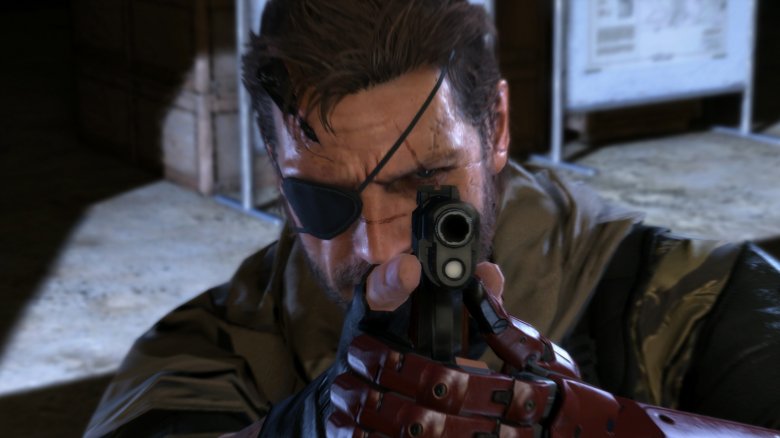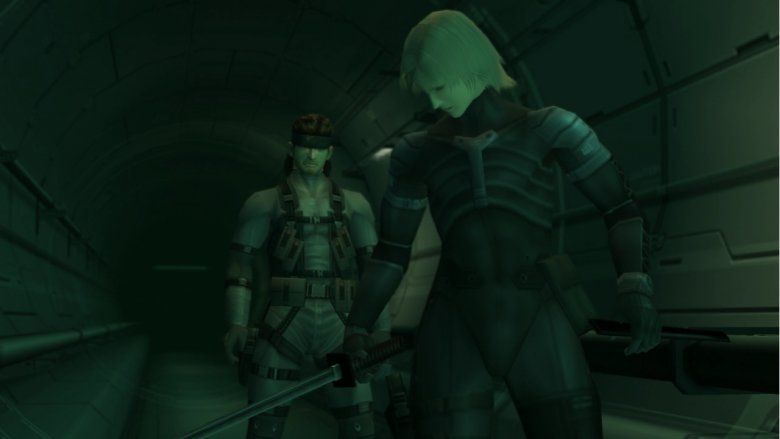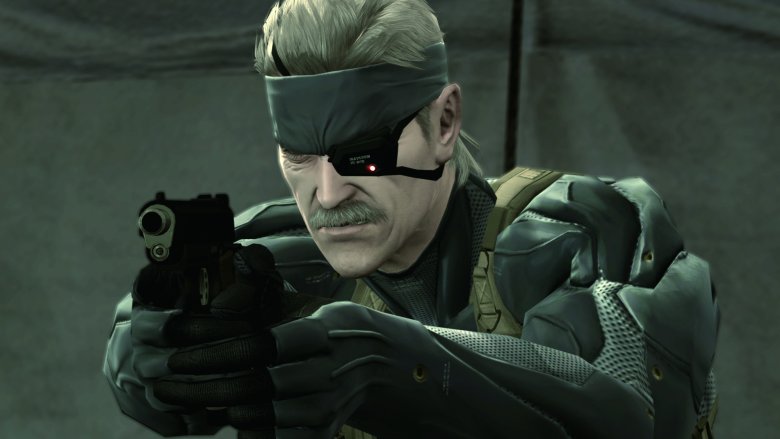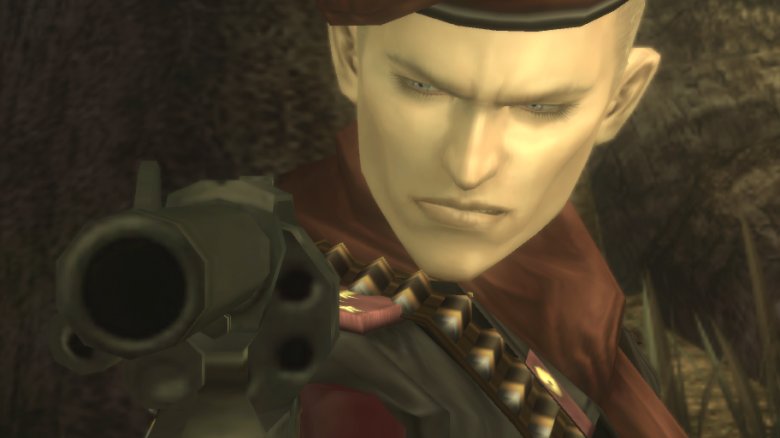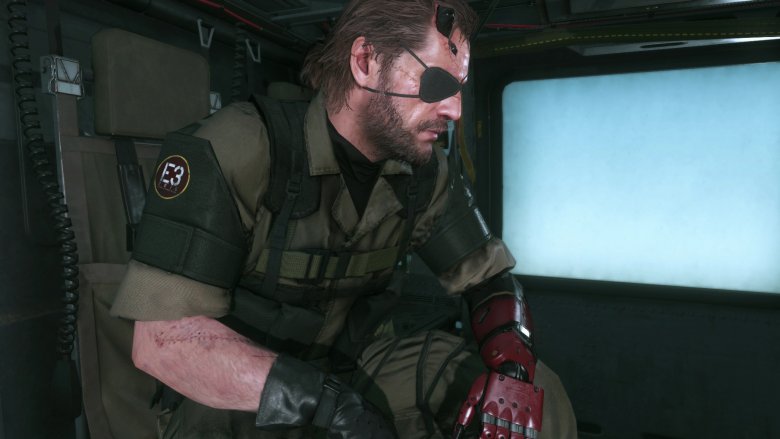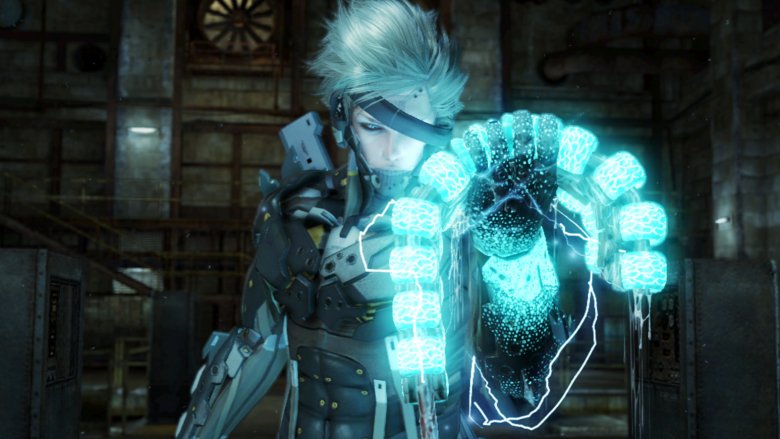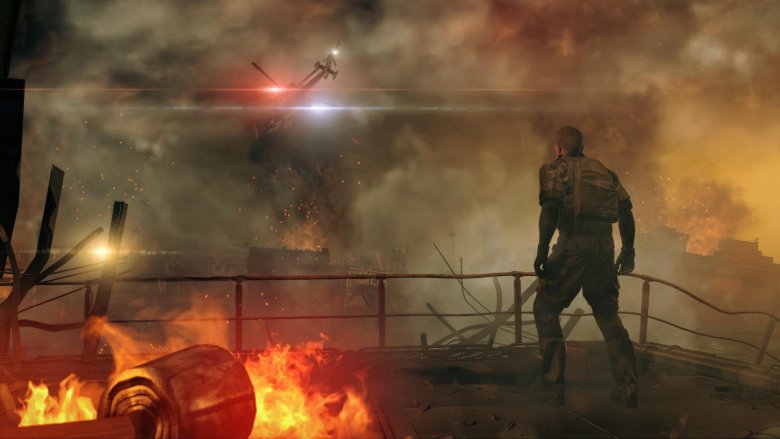The Untold Truth Of Metal Gear Solid
Metal Gear Solid is one of the seminal franchises in video game history: the progenitor of the tactical stealth genre, featuring one of the most elaborate and involved storylines in the medium. The series contains everything from Western military fiction, to anime sensibilities, to espionage narratives, to conspiracy theories, to philosophical diatribes–all while innovating gameplay mechanics and boss battles that are still unrivaled decades later. But for as zany and obtuse as the story can be, and as difficult and challenging as the gameplay can be, the series was played by millions and actually grew more popular as it progressed. There's never been anything quite like it...and there never will be again.
In a series built on twists, hidden information, and unexpected reveals, it shouldn't be surprising that there's a lot in Metal Gear Solid's own history that most players aren't aware of. Here's everything you might not have known about a couple of guys named Snake.
The series wasn't originally "Solid"
The first game in the franchise, Metal Gear Solid, debuted on the original PlayStation in 1998 and changed the gaming landscape forever. Right? Well, yes–except that it wasn't the first game in the franchise. In fact, series mastermind Hideo Kojima had made a 2D stealth-action title called Metal Gear, without the "Solid," in 1987. This is, indeed, the same franchise: the hero, Solid Snake, and the villain, Big Boss, remain the central characters throughout all the other games. Many of the series' staples, such as the mix of stealth and combat and the reliance on espionage technology, not to mention the wildly twisting narrative, are all present in Metal Gear. And indeed, the game was such a success that it spawned a sequel: still not Solid, but rather Metal Gear 2.
So why wasn't it until the 1998 game that the franchise got famous the world over? One big factor was that the first two games originally released for the MSX2 computer. The MSX product line only ever really took off in Japan and some parts of Europe, so there wasn't much of a global audience for games exclusive to that platform. Konami did later make a port of Metal Gear for the Nintendo Entertainment System, but this was a heavily modified product without Kojima's involvement. And that port even spawned its own sequel, Snake's Revenge, which Kojima also had nothing to do with.
In addition, the original games didn't have captivating graphics or cutscenes, the way that Solid would have later. Even if you did have an MSX2, there was nothing about the Metal Gear games that made it stand out from the competition. Not yet, anyway. Solid's switch to the PlayStation, which was sold in all major markets, finally gave a Kojima-designed Metal Gear the potential for a breakthrough–and break through it did.
For those curious: both these original games were later included in Metal Gear Solid 3: Subsistence as a bonus feature, so if you own any version of Subsistence, you can try them out for yourself.
Snake was Snake before Snake was Snake
The gruff voice. The ice-cool demeanor. The perfect blend of infiltrator and warrior. As lethal with his hands as with a gun. He is: Snake.
Call him Plisskin.
Kurt Russell turned in a memorable performance as world-weary anti-hero Snake Plisskin in the 1981 John Carpenter film Escape from New York. The movie involves Snake being recruited, against his will, into rescuing the President of the United States from the toughtest maximum security prison in the world: the entire island of Manhattan. Alone, surrounded by heavily-armed enemies, with nothing but a few hi-tech gadgets and a couple of cigarettes, Snake makes his way through the prison by scouting the terrain, finding allies, and eventually overcoming colorful enemies with endless guards. Does any of this sound familiar? Welcome to the first Metal Gear story, before Metal Gear ever existed.
Hideo Kojima is an enormous film buff, and has a soft spot for Western action films. He loved Escape from New York, and was blown away by Russell's turn as Snake. So when it came time for Kojima to make his own work, he created a character with Snake's resolve, Snake's machismo, and Snake's skillset–and called him Solid Snake (and was nearly sued for it, apparently).
But if anybody was watching closely, they might have noticed that Solid Snake didn't have Snake Plisskin's eyepatch. Curiously, the villain, Big Boss, did. That was a very subtle clue for a future reveal: that Big Boss was once a Snake himself, and that Solid is his clone. Metal Gear Solid 3 would later show how he earned the patch.
"Solid" didn't just mean Snake
When the franchise finally did conquer the world in 1998, it was with its first PlayStation title, Metal Gear Solid. The name is signficant, in that it is not simply Metal Gear 3, even though it was the third game in the series. There were a number of reasons for this. First, since not too many people outside Japan ever played the first two games, Konami wanted to have a fresh start with the franchise's numbering. But while you might assume that Solid referred to the main character–Solid Snake–that's not the only reason.
Kojima has mentioned that "Solid" was also a reference to three-dimensional polygons. That in itself had two meanings. First, there was the simple fact that this was the first Metal Gear game to use polygons rather than 2D sprites. But second, this reference to 3D was a play on the fact that this was the third game: solid metrics are always measured in the third power, after all. In other words, solid objects are represented in cubed units. And what is a cube the next step from? A square. And SquareSoft was one of Konami's biggest competitors at the time. Konami wanted to show that they were going a step beyond their rival.
The name Metal Gear Solid, in other words, encapsulates a lot of what made Kojima's game great in the first place: it was simple and cool, yet multilayered and profound at the same time. It was also, if we're being honest, just a little bit goofy–out of context, "metal gear solid" doesn't even sound like proper grammar. Just like the game itself.
Metal Gear Solid 2 is a negative reflection of Metal Gear Solid
A lone operative infiltrates a remote facility that's been taken over by terrorists. The terrorists are trying to gain control of a nuclear-armed device called a Metal Gear. A scientist named Emmerich is the key to completing the Metal Gear project. A president is being held hostage. Quick: is this a description for Metal Gear Solid, or Metal Gear Solid 2: Sons of Liberty?
The answer, of course, is "both." Now, many sequels feature similar setups to the original. But Metal Gear Solid 2 took this much, much further. In fact, on closer analysis, the second game is almost a remake of the first. For example, the first boss battle in both games is a close-range gunfight filled with explosives, and in fact, many of the boss battles feature near-identical design choices. Later, the hero is attacked from the air while moving between locations: by a helicopter in the first game, and a Harrier jet in the second. Even the torture room in the sequel is a carbon copy from the one in the original.
This similarity is later revealed to be a narrative choice. Snake's mission in the original game is considered to be so perfect that the military has created a virtual recreation in order to train new operatives. If Metal Gear Solid 2 feels like Metal Gear Solid in another skin, that's because it is–canonically.
"Solid Snake" hasn't been the protagonist since the first Metal Gear Solid
Solid Snake is the hero of the franchise, the character gamers play as throughout the experience. He is, in fact, one of the most famous heroes in the whole medium. Right? Well, sort of. Sometimes. Most players are aware that the franchise actually has two protagonists: Solid Snake, and his own clone-father and worst enemy, Big Boss. But before he was known as Big Boss, he was a Snake, too. In fact, as later games explore Big Boss' origins, it becomes clear that he was once very similar to the man his clonen would become: implacable, courageous, and fiercely dedicated to his mission.
But which Snake was he? And for that matter, which Snake was Solid? From the original Metal Gear through Metal Gear Solid, Solid Snake is the hero, full stop. But starting with Metal Gear Solid 2, Hideo Kojima began subverting this simple expectation. Beyond that famous bait-and-switch with the player character, when Raiden is raveled to be the game's actual protagonist, this is the very last entry that ever uses the name "Solid Snake."
The next game, Metal Gear Solid 3: Snake Eater, takes us back to Big Boss' roots as a special operator for the CIA. His code name is not Solid Snake, but Naked Snake. This is only ever referenced in textual form: in dialogue, he's only ever called "Snake," which is true throughout the franchise. Then in Metal Gear Solid 4: Guns of the Patriots, the original hero returns, but is referred to only as Old Snake, not Solid. The two follow-up games, Metal Gear Solid: Peace Walker and Metal Gear Solid V: The Phantom Pain, both star Big Boss again, and with two new names: simply as Snake in the former, and as Venom Snake in the latter.
Since Metal Gear Solid 2 in 2001, there has only been one reference to "Solid" Snake: in the final, fighting game-style boss fight of Metal Gear Solid 4, where the names and health bar visuals of the characters are references to earlier games.
There's a way to prevent the entire series from happening
Early in Metal Gear Solid 3: Snake Eater, the protagonist Naked Snake has a duel with a young Soviet officer. Snake learns that this man is the commander of the GRU's Ocelot unit. Snake dispatches the Ocelot unit, knocks the commander out, and proceeds on his mission. Throughout the remainder of that game, the Ocelot commander–now, following Snake's own advice, using a revolver–hunts Snake and fights him at every turn. Ocelot is even responsible for the shot that gives Big Boss his signature look: his eyepatch.
And that's just in Metal Gear Solid 3, the chronologically earliest game in the series. As the story continues, Revolver Ocelot seemingly joins, and betrays, every single side of every single conflict. He is at the heart of every conspiracy, usually with an agenda his own allies aren't aware of. By the end of the franchise, Ocelot has become the vessel for the soul (and arm) of Solid Snake's twin, Liquid Snake. Ocelot, in other words, is the keystone of the whole series. Everything else is built around him; even the various Snakes spend most of their time just reacting to Ocelot's schemes.
In other words, no Ocelot, no Metal Gear Solid. But let's go all the way back to the beginning, shall we? In the very first meeting of a Snake and an Ocelot, it's Snake who wins the duel and incapacitates Ocelot. This all happens in a cutscene, but when the player is given control again, Ocelot is lying right there at Snake's feet. What if the player simply, you know, shoots Ocelot? In that case, the game actually casts a game over screen, saying "Ocelot Is Dead" and "Time Paradox." Ocelot is so central to the franchise that killing him is its own distinct fail state.
For the HD re-release on the PlayStation 3, this particular endgame condition is linked to a tropy: "Problem Solved, Series Over."
The Beauty and the Beast characters are remixes of earlier bosses
In Metal Gear Solid 4: Guns of the Patriots, most of the bosses that Old Snake must defeat are from the Beauty and the Beast unit: four psychologically traumatized women in highly-advanced battle suits. While these are new characters introduced for this game, they were in fact a metatextual reference to characters throughout the Metal Gear Solid franchise. Each of them had a name consisting of an emotion and an animal, and each had a distinctive weapon. But each of those three components derived from earlier enemies, and specifically, each animal came from Metal Gear Solid, each weapon came from Metal Gear Solid 2, and each emotion came from Metal Gear Solid 3.
For example, the first Beauty that Snake encounters is called Laughing Octopus. "Octopus" refers to Decoy Octopus, the villain disguised as an ally in the first game; her P90 submachine gun and tentacles resemble archvillain Solidus Snake from the sequel; and the "Laughing" emotion is a reference to The Joy, the codename for the character The Boss from the third game.
Indeed, Metal Gear Solid 4 is both a brand-new game and an exquisitely rendered tribute to the earlier titles in the series. And of course, one of the series' most distinguished features are its complex boss battles. The Beauty and the Beast Unit are brand-new characters, and players must solve brand new puzzles. But they're also the summation of everything that has come before them. Just like the game as a whole.
Hideo Kojima left the series. Over and over. And then came back.
Hideo Kojima is the heart of the Metal Gear series. Director and co-writer on all of the major titles in the saga, Kojima had a unique ability to blend genres, traditions, and philosophical concepts to produce games unlike anything else on the market. How many other series would feature metatextual references to the nature of the design of earlier entries? For that matter, how many games can blend Western military-espionage fiction with Eastern anime villains? Kojima has always gone where no one else even thought to try.
So it really was a shame when he left the franchise after the very first Metal Gear Solid. And, also, when he left after Metal Gear Solid 2, which he directed. Oh, and also Metal Gear Solid 3, which he also directed. And definitely when he left after Metal Gear Solid 4, which he directed, right before he directed Peace Walker, after which he left the series, before directing Metal Gear Solid V: The Phantom Pain.
If that made less sense to you than, say, a Metal Gear Solid plotline, you're not alone. Kojima has a long history of declaring that he was done with the franchise, only to return like...well, like a Metal Gear Solid villain. Partly, this seems to be because the story was so huge that it took multiple games to finish it off–and even today, there are gaps in the narrative's chronology. But more likely, it seems like Kojima is just so tied up in this wacky, weird, wonderful franchise, that he just couldn't give it away to somebody else.
With one exception...
Metal Gear Rising: Revengeance was made without Kojima
Metal Gear Rising: Revengeance was intended to be a side-story in the grander Metal Gear narrative, exploring the world outside of the Snake melodrama. Revengeance stars Raiden, the hero of Metal Gear Solid 2, taking place after the events of Metal Gear Solid 4. Maybe because of the absence of a Snake, Kojima finally followed through on his promise to not make a Metal Gear game. He chose to pass off directing duties.
That didn't make the development easy on him. Naturally, he originally wanted the game developed at his own studio, Kojima Productions. That way, he could still keep an eye on it while fostering new talent at his company. Unfortunately, the project didn't go very well. Without the guiding vision of their big boss, Kojima Productions simply couldn't cobble together a coherent vision for the game.
Kojima was on the verge of cancelling the project, but true to form, came up with an insane notion instead: give the game to another company. Specifically, Platinum Games, most famous for their Bayonetta franchise. Platinum weren't exactly renowned for deep stories, and their brand of ultra-fast-paced, super-stylish action didn't really mesh with Metal Gear's slow, methodical, stealthy approach. Who would ever think to synthesize two studios that had nothing in common? Only Kojima, who had made a career out of synthesizing completely different ideas into one great game. And so came Revengeance, which, to everyone's surprise, turned out to be pretty good.
Kojima is gone, but Metal Gear is not
In a twist worthy of the franchise he created, Kojima was fired by parent company Konami in 2015. The reasons have never been fully revealed publicly, but it all seems to center around a corporate restructuring that happened right around the same time. With new management and new priorities, a wildcard like Kojima–who didn't understand words like "schedule" and "budget"–was simply no longer a fit. Never mind all the revenue and prestige he'd brought Konami over the years; he was kicked out the door.
Which means that, at long last, when Kojima says he's not making a Metal Gear game, he means it. His next project will be the mysterious Death Stranding, which by its trailers will make Metal Gear Solid games look sane and rational. But this is not the death of Metal Gear. Konami, sans Kojima, has already announced Metal Gear Survive, an open-world survival-action game that seems to be cashing in on the zombie craze. How that fits into the overall Metal Gear story is anybody's guess. But doubtless, other Metal Gear games will follow after. Can a franchise so singularly bound up with its creator thrive without him? Time will tell.

